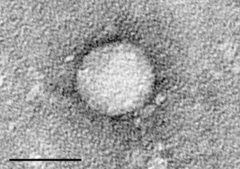ヘパシウイルス属
ヘパシウイルス属(Hepacivirus)は、フラビウイルス科の一本鎖プラス鎖RNAウイルスの属である[1]。ヘパシウイルスCに属するC型肝炎ウイルス(HCV)は、肝炎及び肝細胞癌に関連する[2]ウイルスで、知られている範囲では、ヒトを唯一の自然宿主としている。
| へパシウイルス属 | |||||||||||||||||||||
|---|---|---|---|---|---|---|---|---|---|---|---|---|---|---|---|---|---|---|---|---|---|
 細胞培養液から精製されたへパシウイルスCの電子顕微鏡写真。スケールバーは50nm。
| |||||||||||||||||||||
| 分類(ICTV) | |||||||||||||||||||||
| |||||||||||||||||||||
| タイプ種 | |||||||||||||||||||||
| へパシウイルスC |
分類学
編集この属に属すウイルスは、ヘパシウイルスA~Pの、15種に分類されている[3][1]。
- ヘパシウイルスA - イヌヘパシウイルス、非霊長類ヘパシウイルス、馬ヘパシウイルスを含む。
- ヘパシウイルスB - GBV-Bウイルスを含む。
- ヘパシウイルスC - 以前の種、C型肝炎ウイルスに含まれるウイルス、C型肝炎ウイルスを含む。
- ヘパシウイルスD - Guereza hepacivirus を含む。
- ヘパシウイルスE - rodent hepacivirus-339 を含む。
- ヘパシウイルスF - rodent hepacivirus-NLR07-oct70 を含む。
- ヘパシウイルスG - Norway rat hepacivirus 1 を含む。
- ヘパシウイルスH - Norway rat hepacivirus 2 を含む。
- ヘパシウイルスI - rodent hepacivirus-SAR-3/RSA/2008 を含む。
- ヘパシウイルスJ - rodent hepacivirus-RMU10-3382/GER /2010 を含む。
- ヘパシウイルスK - bat hepacivirus-PDB-829 を含む。
- ヘパシウイルスL - bat hepacivirus-PDB-112 を含む。
- ヘパシウイルスM - bat hepacivirus-PDB-491.1 を含む。
- ヘパシウイルスN - ウシヘパシウイルスを含む。
- ヘパシウイルスP - オナガホッキョクジリスに感染する[4]。
この他にも、シラガタケネズミ(Rhizomys pruinosus)から分離された新しいウイルスがあるが、先述した属のいずれにも属していない[5]。
また、この分類群に含まれる別の未分類のウイルスは、アヒルヘパシウイルスに似たウイルスである[6]。
構造
編集ヘパシウイルス属のウイルスは、球形の構造に包まれており、直径は約50nmである。遺伝子は線形で、分割されておらず、長さは10kb(キロベース)である[1][2]。
| 属 | 構造 | 対称 | カプシド | ゲノム配列 | ゲノム断片 |
|---|---|---|---|---|---|
| ヘパシウイルス | 二十面体に近い | 擬似T = 3 | 包まれている | 線形 | 単文節 |
ライフサイクル
編集宿主細胞への侵入は、ウイルスエンベロープタンパク質Eを、クラスリン依存性エンドサイトーシスを取り成す宿主の受容体に付着させることにより、達成される。侵入後は、プラス鎖RNAウイルスの複製・転写の方式で増殖する。また、翻訳は、ウイルス自身が開始する。人間は、自然宿主として機能し、性的接触や血液を介して感染する[1][2]。
| 属 | 宿主 | 組織の向性 | 侵入の詳細 | 放出の詳細 | 複製場所 | 構築場所 | 感染経路 |
|---|---|---|---|---|---|---|---|
| ヘパシウイルス | 人間 | 皮膚上皮組織、腎臓上皮組織、腸管上皮組織、精上皮組織 | クラスリン依存性エンドサイトーシス | 分泌 | 細胞質 | 細胞質 | 性的接触、血液 |
歴史
編集人においてC型肝炎の病原体であり、ヘパシウイルスCに分類されるC型肝炎ウイルス(HCV)は、1989年に発見された[8]。現在までに、C型肝炎ウイルスの1~7までの7つの遺伝子型と、1a、1bなどの86のサブタイプ(亜型)が命名されている[9]。
1995年に発見されたGBV-Bウイルス(GBウイルスBとしても知られる)は、広鼻猿、特にタマリンに感染することができるウイルスで、HCVと同様に、血液媒介経路によって伝播され、ウイルス性肝炎に関連している。しかし、GBV-Bは野生動物で確認されたことはなく、その自然宿主は不明である[8]。
追加情報
編集その他のヘパシウイルスは、コウモリ、ハタネズミを含むげっ歯類、ウマおよびイヌから報告されている[10][11][12]。
牛は、ヘパシウイルスN種に属するウイルスの宿主でもあるようである[13] [14]。
げっ歯類ヘパシウイルスは、シカマウス(Peromyscus maniculatus)に見られる[8]。
優雅なネコザメ(Proscyllium habereri)からも、ヘパシウイルスに関連するウイルスが分離された[15]。
ウマヘパシウイルスには少なくとも2つのサブタイプがある[16]。
ヘパシウイルスCに最も密接に関連するウイルスは、ヘパシウイルスA種に属するウマヘパシウイルスである[17]。
ヘパシウイルスAはロバにも感染することが分かっている[18]。
参照資料
編集- ^ a b c d “Flaviviridae” (英語). International Committee on Taxonomy of Viruses (ICTV). 2020年1月6日閲覧。
- ^ a b c “Viral Zone”. ExPASy. 15 June 2015閲覧。
- ^ Smith, Donald B; Becher, Paul; Bukh, Jens; Gould, Ernest A; Meyers, Gregor; Monath, Thomas; Muerhoff, A. Scott; Pletnev, Alexander et al. (2016). “Proposed update to the taxonomy of the genera Hepacivirus and Pegivirus within the Flaviviridae family”. Journal of General Virology 97 (11): 2894–2907. doi:10.1099/jgv.0.000612. PMC 5770844. PMID 27692039.
- ^ Li LL, Liu MM, Shen S, Zhang YJ, Xu YL, Deng HY, Deng F, Duan ZJ (2019) Detection and characterization of a novel hepacivirus in long-tailed ground squirrels (Spermophilus undulatus) in China. Arch Virol
- ^ Van Nguyen, Dung; Van Nguyen, Cuong; Bonsall, David; Ngo, Tue; Carrique-Mas, Juan; Pham, Anh; Bryant, Juliet; Thwaites, Guy et al. (2018). “Detection and Characterization of Homologues of Human Hepatitis Viruses and Pegiviruses in Rodents and Bats in Vietnam”. Viruses 10 (3): 102. doi:10.3390/v10030102. PMC 5869495. PMID 29495551.
- ^ Chu L, Jin M, Feng C, Wang X, Zhang D (2019) A highly divergent hepacivirus-like flavivirus in domestic ducks. J Gen Virol
- ^ Goldberg TL, Sibley SD, Pinkerton ME, Dunn CD, Long LJ, White LC, Strom SM (2019) Multidecade mortality and a homolog of Hepatitis C Virus in bald eagles (Haliaeetus leucocephalus), the national bird of the USA. Sci Rep 9(1):14953
- ^ a b c Stapleton, J. T; Foung, S; Muerhoff, A. S; Bukh, J; Simmonds, P (2010). “The GB viruses: A review and proposed classification of GBV-A, GBV-C (HGV), and GBV-D in genus Pegivirus within the family Flaviviridae”. Journal of General Virology 92 (2): 233–46. doi:10.1099/vir.0.027490-0. PMC 3081076. PMID 21084497.
- ^ “HCV Classification” (英語). International Committee on Taxonomy of Viruses (ICTV). 2020年1月6日閲覧。
- ^ Kapoor, A; Simmonds, P; Scheel, T. K. H; Hjelle, B; Cullen, J. M; Burbelo, P. D; Chauhan, L. V; Duraisamy, R et al. (2013). “Identification of Rodent Homologs of Hepatitis C Virus and Pegiviruses”. mBio 4 (2): e00216–13. doi:10.1128/mBio.00216-13. PMC 3622934. PMID 23572554.
- ^ Drexler, Jan Felix; Corman, Victor Max; Müller, Marcel Alexander; Lukashev, Alexander N; Gmyl, Anatoly; Coutard, Bruno; Adam, Alexander; Ritz, Daniel et al. (2013). “Evidence for Novel Hepaciviruses in Rodents”. PLoS Pathogens 9 (6): e1003438. doi:10.1371/journal.ppat.1003438. PMC 3688547. PMID 23818848.
- ^ Lauck, M; Sibley, S. D; Lara, J; Purdy, M. A; Khudyakov, Y; Hyeroba, D; Tumukunde, A; Weny, G et al. (2013). “A Novel Hepacivirus with an Unusually Long and Intrinsically Disordered NS5A Protein in a Wild Old World Primate”. Journal of Virology 87 (16): 8971–81. doi:10.1128/JVI.00888-13. PMC 3754081. PMID 23740998.
- ^ Corman, Victor Max; Grundhoff, Adam; Baechlein, Christine; Fischer, Nicole; Gmyl, Anatoly; Wollny, Robert; Dei, Dickson; Ritz, Daniel et al. (2015). “Highly Divergent Hepaciviruses from African Cattle”. Journal of Virology 89 (11): 5876–82. doi:10.1128/JVI.00393-15. PMC 4442428. PMID 25787289.
- ^ Baechlein, Christine; Fischer, Nicole; Grundhoff, Adam; Alawi, Malik; Indenbirken, Daniela; Postel, Alexander; Baron, Anna Lena; Offinger, Jennifer et al. (2015). “Identification of a Novel Hepacivirus in Domestic Cattle from Germany”. Journal of Virology 89 (14): 7007–15. doi:10.1128/JVI.00534-15. PMC 4473572. PMID 25926652.
- ^ Shi, Mang; Lin, Xian-Dan; Vasilakis, Nikos; Tian, Jun-Hua; Li, Ci-Xiu; Chen, Liang-Jun; Eastwood, Gillian; Diao, Xiu-Nian et al. (2016). “Divergent Viruses Discovered in Arthropods and Vertebrates Revise the Evolutionary History of the Flaviviridae and Related Viruses”. Journal of Virology 90 (2): 659–69. doi:10.1128/JVI.02036-15. PMC 4702705. PMID 26491167.
- ^ Pronost, S; Hue, E; Fortier, C; Foursin, M; Fortier, G; Desbrosse, F; Rey, F. A; Pitel, P.-H et al. (2017). “Prevalence of Equine Hepacivirus Infections in France and Evidence for Two Viral Subtypes Circulating Worldwide”. Transboundary and Emerging Diseases 64 (6): 1884–1897. doi:10.1111/tbed.12587. PMID 27882682.
- ^ Thézé, Julien; Lowes, Sophia; Parker, Joe; Pybus, Oliver G (2015). “Evolutionary and Phylogenetic Analysis of the Hepaciviruses and Pegiviruses”. Genome Biology and Evolution 7 (11): 2996–3008. doi:10.1093/gbe/evv202. PMC 5635594. PMID 26494702.
- ^ Walter S, Rasche A, Moreira-Soto A, Pfaender S, Bletsa M, Corman VM, Aguilar-Setien A, García-Lacy F, Hans A, Todt D, Schuler G, Shnaiderman-Torban A, Steinman A, Roncoroni C, Veneziano V, Rusenova N12, Sandev N12, Rusenov A, Zapryanova D, García-Bocanegra I, Jores J, Carluccio A, Veronesi MC, Cavalleri JMV, Drosten C, Lemey P, Steinmann E, Drexler JF (2016) Differential infection patterns and recent evolutionary origins of Equine Hepaciviruses in donkeys. J Virol 91(1)